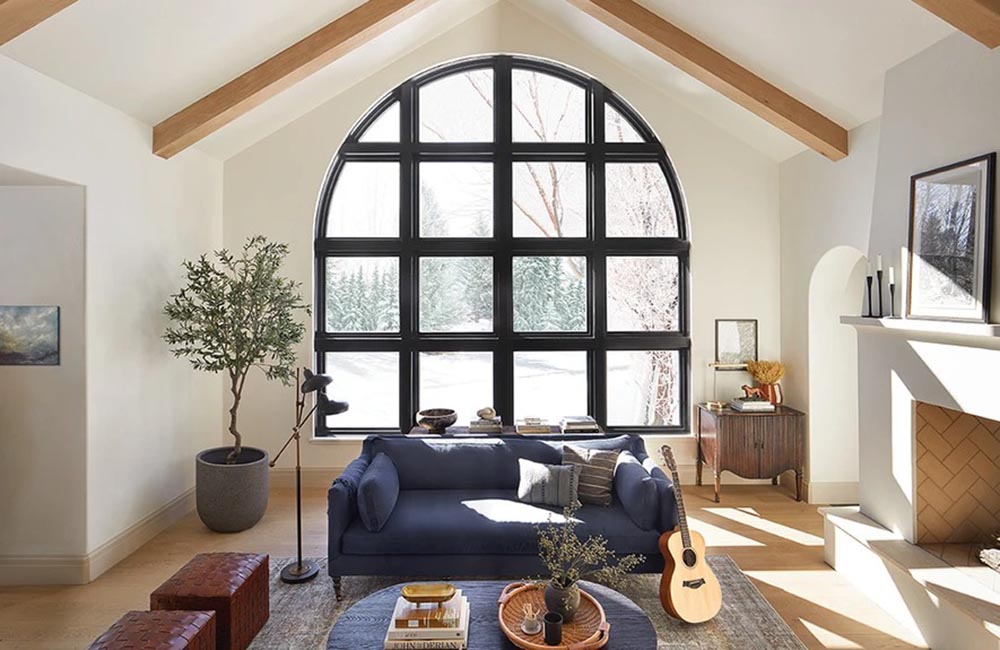We may earn revenue from the products available on this page and participate in affiliate programs. Learn More ›
It seems as if most people only think about the windows in their home when there is an issue to address: maybe the windows are in desperate need of being washed, or one struggles to open. Bigger issues, such as high utility bills, can be attributed to outdated windows. Windows are part of the structure of the home, and because they’re not inexpensive to replace, they’re not often on the “must-do” list of home improvements until, very suddenly, they need to be. Pella is one of the oldest and most recognizable names in the window and door marketplace. Made in the United States and sold through independent professionals, showrooms, in-home consultations, and Lowe’s stores nationwide, Pella windows have a solid foothold in the replacement and new- construction window and door marketplace at all price points.
Windows, once a simple pane of glass puttied in between staves of wood and hammered into place, are now highly technical home construction elements, and selecting the right ones can be a daunting task. Customers will need to make decisions about style, color, opening hardware, materials, glass styles and levels of insulation, and size. Screens? No screens? What about grids? There are a host of questions to answer, and they’re all important—because new windows will radically change the appearance and feel of a house both inside and out. Each window and door company offers a different set of options, so understanding Pella’s range of products makes it easier to hold up the company against its competitors and see where it stands. I evaluated Pella’s commitment to finding the right products for each customer, straightforward ordering process, smooth installation day, and warranties and guarantees from a customer’s perspective.
See more of the best window replacement companies.
At a Glance
Pella Windows & Doors
Pros
- Wide selection of window styles and materials, including Low-E and energy-efficient glass options
- Technicians can install integrated smart-home technology
- Over 150 patents on window technology and innovation
Cons
- Some warranties are nontransferable
- Limited door style options
Specs
- Availability: Nationwide
- Consultation: In-home or virtual
- Scheduling: Online
- Financing: Yes
- Customer service: Phone, email, text message
- Warranty: 10 to 20 years on components, 2 years on labor
Our Verdict: Is Pella a good window brand? Pella’s products are innovative and exciting, and the company offers a wide range of styles, materials, and accessories that will enable and empower customers to find the right windows for their homes, whether it means quick and efficient shopping or a more detail-focused customization process. There are some concerns about the warranty process, but those issues are easily outweighed by the outstanding selection of energy-efficient products and customization options.
Pella Windows & Doors Review: Claims
Pella promises innovation through new products and unique tweaks to old ones, a passion for design and customer service, and a commitment to the environment via sustainable practices, waste reduction, and recycling. While Pella is primarily known for windows, it also fabricates and installs doors in complementary styles for whole-house consistency—although the doors tend to be more traditionally styled than some of the windows, which could limit the flexibility for customers to match materials and finishes. The wide range of options can be a little overwhelming, but a cleanly laid-out website and well-written definitions and explanations make the shopping a little easier to navigate.
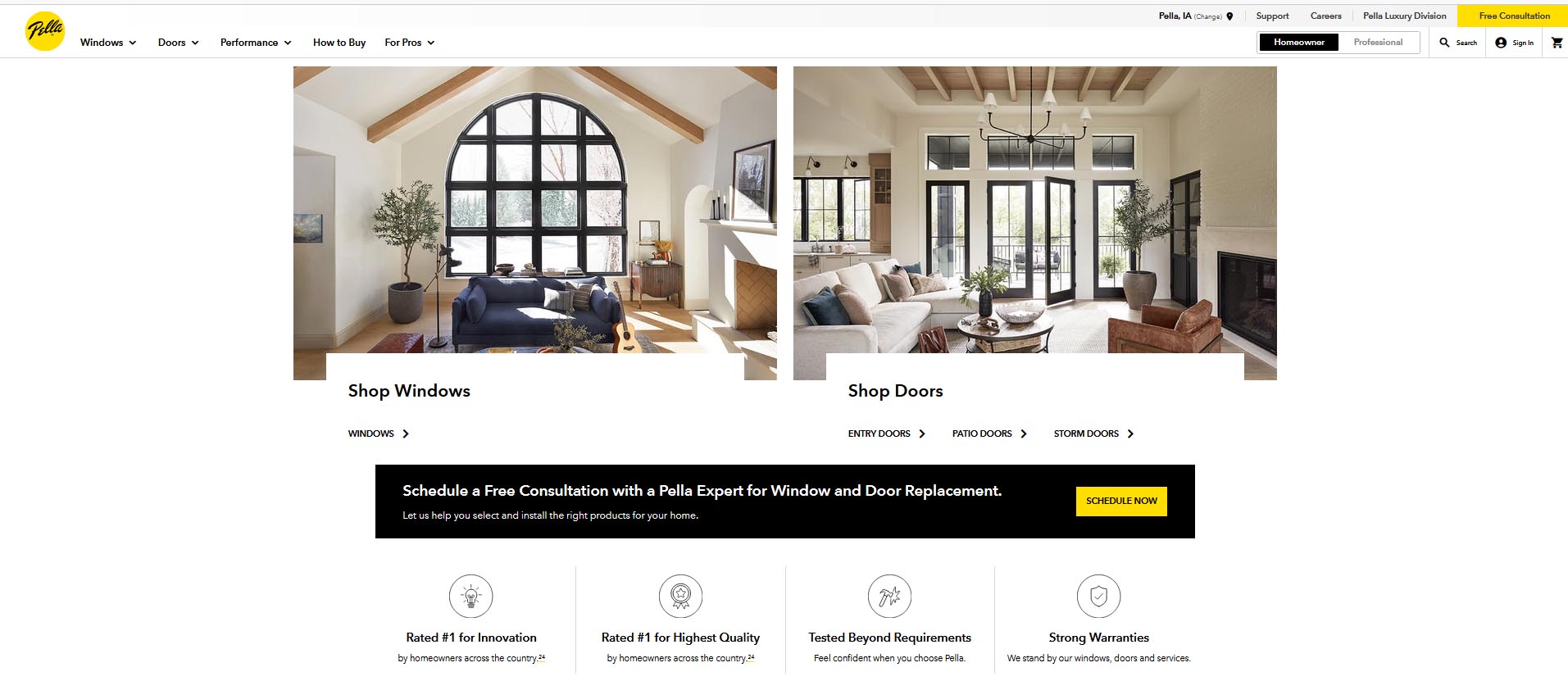
How It Works
Pella’s home page greets customers with an appealing, beautiful shot of its product. It begins by focusing not on the windows themselves, but on the customers’ pride of ownership. Rather than feeling immediately bombarded with choices and prices and decisions, customers are instead welcomed into the idea that their home, too, could have this beautiful view if they choose Pella products. There is also an immediate focus on innovation: Pella holds more than 150 unique patents, demonstrating that Pella is constantly researching and working toward the next development in technology and manufacturing, and suggesting to customers that Pella can provide them with something that other companies cannot. On the surface, it’s a great sales pitch, and the pitch is backed up with a photo wall of those patents.
The site is well organized. The top banner automatically connects to the site visitor’s nearest showroom and features links to customer service, the Pella Luxury Division, and a highlighted link to schedule a free consultation. The next row provides drop-down menus with information about windows, doors, performance information, and how and where to purchase Pella products, along with a separate drop-down for construction professionals. This link is full of downloads, tools, and resources for architects, designers, and contractors so these businesses can decide whether to choose Pella products and get advice and instruction if they ultimately do.
The customer-directed drop-down menus offer a preview of what is in each menu, allowing the customer to click directly on what they’d like to see. For example, those who know they want to shop for casement windows can hover over “Windows” and click directly on “Casement Windows” to jump to their options. Alternatively, a customer can select “Start Your Window Education.”
While the innovation demonstrated in Pella products is exciting, the “Window Education” section of the website is well built out, and it makes a great go-to page for homeowners who aren’t sure where to start. Pella takes the mystery out of technical terms like “casement” and more by actually defining them. For example, the section about casement windows features photos of casements and the text “Casement windows are hinged at the side and swing outward.” The page then explains some of the features, where casement windows are useful, and what style houses are suited to casements, and then offers a link to explore more about casement windows. This level of detail and information is presented for every style of window Pella offers, as well as each type of material used and most of the hardware and options. It’s a one-stop-shop way for customers to familiarize themselves with terms before digging into the work of shopping and choosing. To add to the experience, the carousel of photos in each section might help customers expand their style choices and preferences.

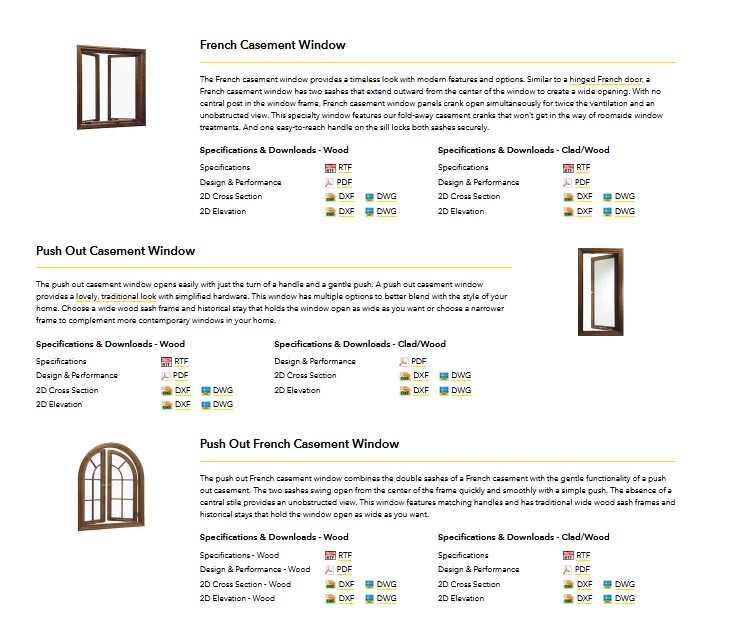
Window and Door Style Choices
Once customers have educated themselves about the various window styles, it’s time to browse through Pella’s style offerings. Pella offers a nearly unlimited range of styles. Traditional window styles such as casement, single- and double-hung, awning, bay, bow, sliding, and picture windows are all available in a range of materials and price points.
In addition, Pella offers a series of specialty windows through its Pella Reserve line, featuring styles that are less common: hopper windows (like awning windows that tilt up instead of down), push-out casement and push-out French casement windows, in-swing casement and in-swing French casement windows, and European-style tile-turn windows. Finally, there’s a custom option: If a customer has a particular vision they’d like realized, or a unique window in their home they’d like to replace, Pella will custom design and fabricate the window. Nearly any shape or combination of shapes is available, and the website helpfully offers some ideas for custom design to help customers start dreaming.

Beyond the shape of the window, the overall appearance can be greatly affected by the details. Selecting a finish (Pella offers seven different wood finishes and a range of colors in vinyl and fiberglass), glass insulation level, screens, and hardware lets customers design their finished window. Clicking on a window style and choosing the “Build” tool will allow customers to flip back and forth between different colors, grilles, and hardware, and then price and add the window to a shopping cart. This tool is quite helpful, even for customers who plan to order through a contractor; switching quickly between the different product lines and materials allows customers to visualize the windows at various price points and identify what they feel is worth the splurge and what might not be.
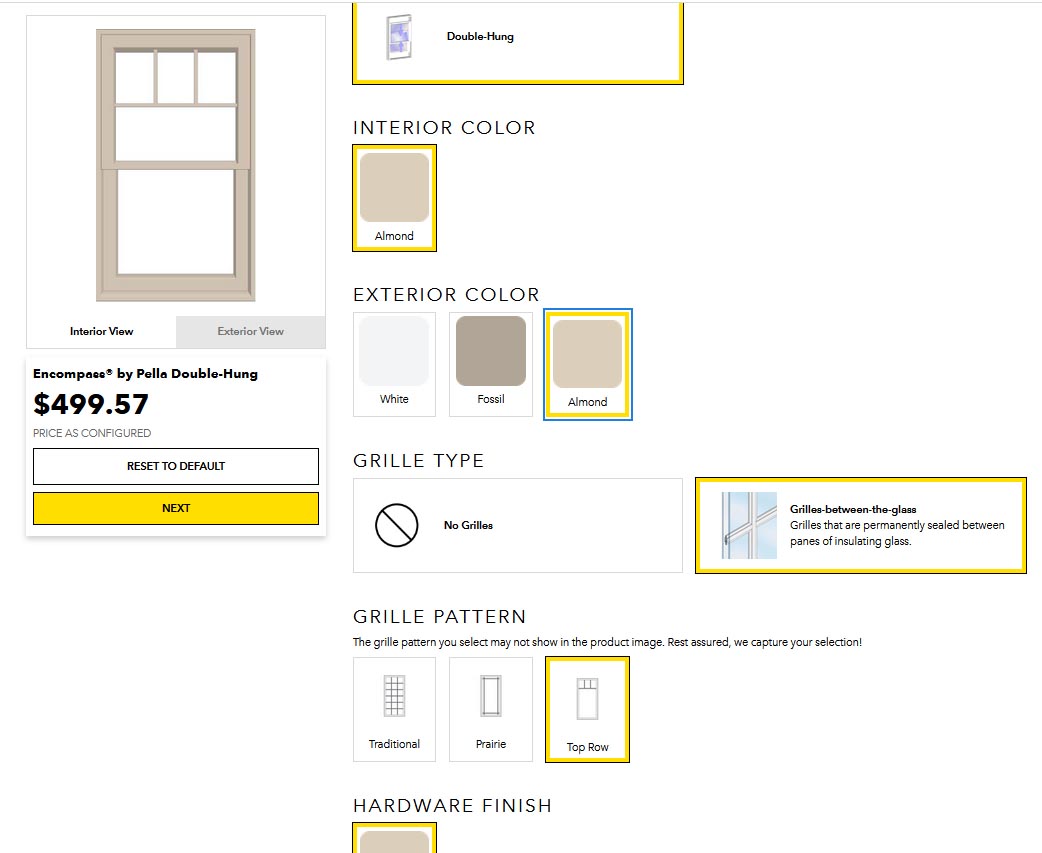
While Pella’s primary market is windows, it also offers an extensive range of patio and entry doors. Are Pella doors good? The patio doors are offered in the same product lines and the same materials as its windows, and the storm and entry doors are crafted from the same materials as well. Therefore, it’s safe to assume that the same care and craftsmanship that goes into the windows also goes into the doors.
Window and Door Materials Selection
Pella products are available in eight product lines, and within those lines each window is available in one of four materials: wood, aluminum-clad wood, fiberglass, or vinyl. Most styles of windows are available in all materials, but the style/material combinations are divided based on which product line the customer selects.
- The Pella Reserve line offers traditional and contemporary windows in wood and aluminum-clad wood, and offers security solutions such as integrated security sensors without compromising on the design features. The Reserve line also exclusively offers the Pella Rolscreen in its single-and double-hung windows. This is a patented design that integrates the screen into the base of the window so that it’s revealed only when the sash is raised, allowing a bright, uninterrupted view through the glass when the window is closed.
- Pella’s Architect Series includes a range of beautifully handcrafted wood windows with exclusive hardware collections. It’s a luxury line, but the visual impact of the windows makes the cost worthwhile for some customers.
- The Lifestyle Series is also a wood product, with a focus on noise reduction and energy efficiency—these windows meet or exceed the Energy Star standards in all 50 states. They are also available with between-the-glass blinds and shades.
-
Pella Impervia windows and doors are constructed from a proprietary fiberglass material, providing strength and durability that surpasses a wood window without requiring significant maintenance. These windows resist extreme heat and cold, repel UV rays, and are suitable for the abrasive and caustic salt of coastal areas.
Pella’s vinyl offerings begin with the 250 Series, which are constructed of an exclusive high-end vinyl that is stronger and more energy efficient than standard vinyl. These windows offer the option of the patented Hidden Screen, which folds away when not in use on single-hung, double-hung, and sliding windows to preserve the clear view through the window when closed, but it protects against insects when the windows are open. Other options include double- or triple-pane glass and additional foam insulation, along with triple weatherstripping for reduced air transfer. - Encompass by Pella is a low-maintenance vinyl window at a budget-friendly price. These windows don’t have as many options as those in the 250 Series, but they are made of a high-grade, warp-resistant vinyl that provides outstanding durability without breaking the bank.
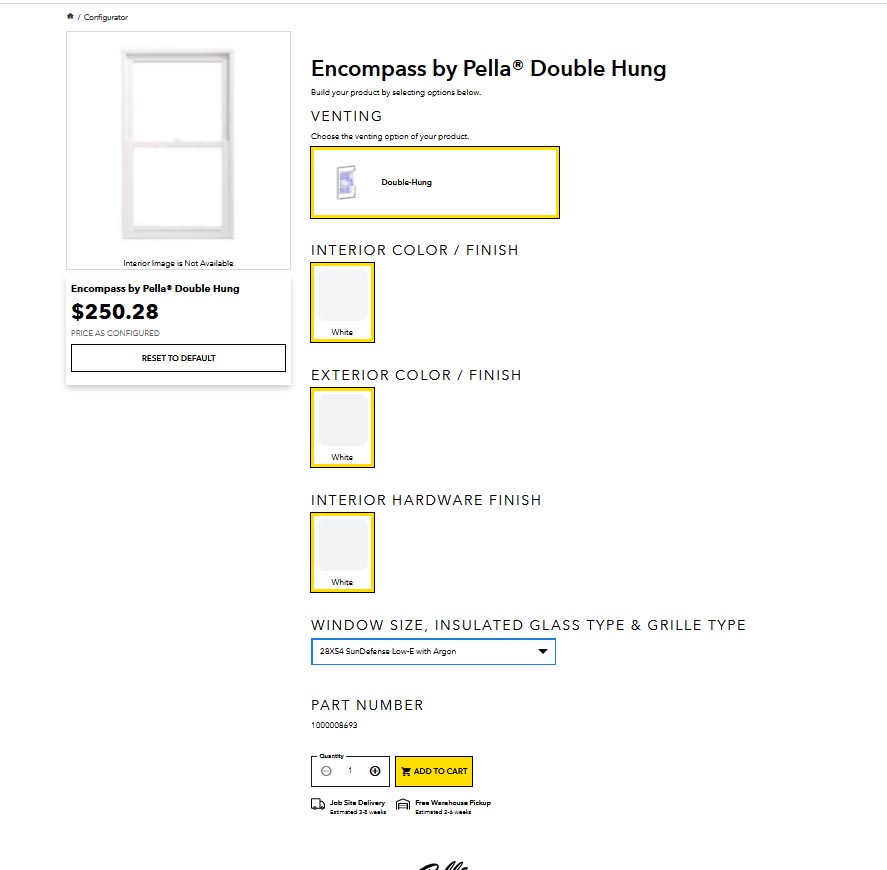
- Finally, Pella offers two specialty series designed for homes where extreme weather is a concern. The Hurricane Shield Series is specifically engineered to hold up in hurricane-force winds and demanding coastal conditions. These windows meet or exceed the strictest requirements of Florida’s building code, which was developed at a higher standard than most to protect homes against high winds and driving rain. They feature an easy installation process to help contractors get the tightest, most secure seal possible, and they provide great everyday performance even when the weather is fair. The Defender Series provides security against weather, intruders, UV rays, and noise. These windows are multilayered and specifically designed to be impact-resistant during storms or attempted break-ins.
Pella has placed a high value on energy efficiency, both as a company and in the manufacturing of its products. Most windows have several glass options: Multiple strengths of Low-E glass prevent UV rays from passing through the windows and damaging furniture, and the same coating helps the windows resist heat transfer between interior and exterior spaces, keeping the home warm during cold weather and cool when it’s hot outside. While all of the windows include a double-pane sealed gas layer to increase insulatory airspace, several of the product lines include an option to upgrade to three panes of glass, ramping up the insulation value even higher. In fact, the Architect Series, Lifestyle Series, and 250 Series windows were honored with the Energy Star Most Efficient Products awards.
Once the windows themselves have been selected, Pella offers a range of window coverings and products to integrate the security of the windows into a smart-home system, via connections through partners in the security and home automation industries. This technology allows owners to check and control the status of their window coverings and locks, and in some cases it offers the ability to lock the windows from afar through the home automation app. While this development is exciting, Pella’s products are not yet compatible with some of the most common purveyors of those technologies, so it’s worth watching as partnerships continue to develop.
Consultation Process
There are several ways to purchase windows and doors from Pella. Some lines are available at Lowe’s home improvement stores, though the selection is limited to certain types and sizes of window. Homeowners who are confident in their ability to DIY a window installation can purchase windows there and complete the installation themselves or pay for Lowe’s to install the items. However, Pella emphasizes the professionalism of its own installers as a key part of the energy efficiency and long lifespan of its products. Certain “in stock” windows can be ordered directly from the Pella website, and the 2- to 10-week lead time is dependent on whether the customer lives close enough to a showroom to pick up the units or needs them delivered to the installation site.
Pella also has showrooms located across the country, so customers who live nearby can drop in and see multiple styles from different lines in person, then plan a consultation with a consultant. This option benefits the customer by providing examples of many different options and providing the opportunity to discuss the benefits and drawbacks of each with an expert.
Every page on Pella’s website offers the opportunity to click to schedule a free consultation—the bright yellow buttons are hard to miss! The request form for a consultation allows the customer to select an in-home consultation or a virtual consultation. Both types allow customers to see samples of Pella products, talk about the purchase and installation procedures, and ask questions; this will result in the consultant providing a quote for the project. The in-home consultation also includes professional measurement of the customer’s windows to ensure that the quote is precise and to streamline ordering. Both types of consultations can be scheduled immediately through the online form, and should the need arise to change the appointment time, that can also be managed through the form. Consultations last about 90 minutes. Customers can also call a toll-free number to schedule a consultation if they prefer.
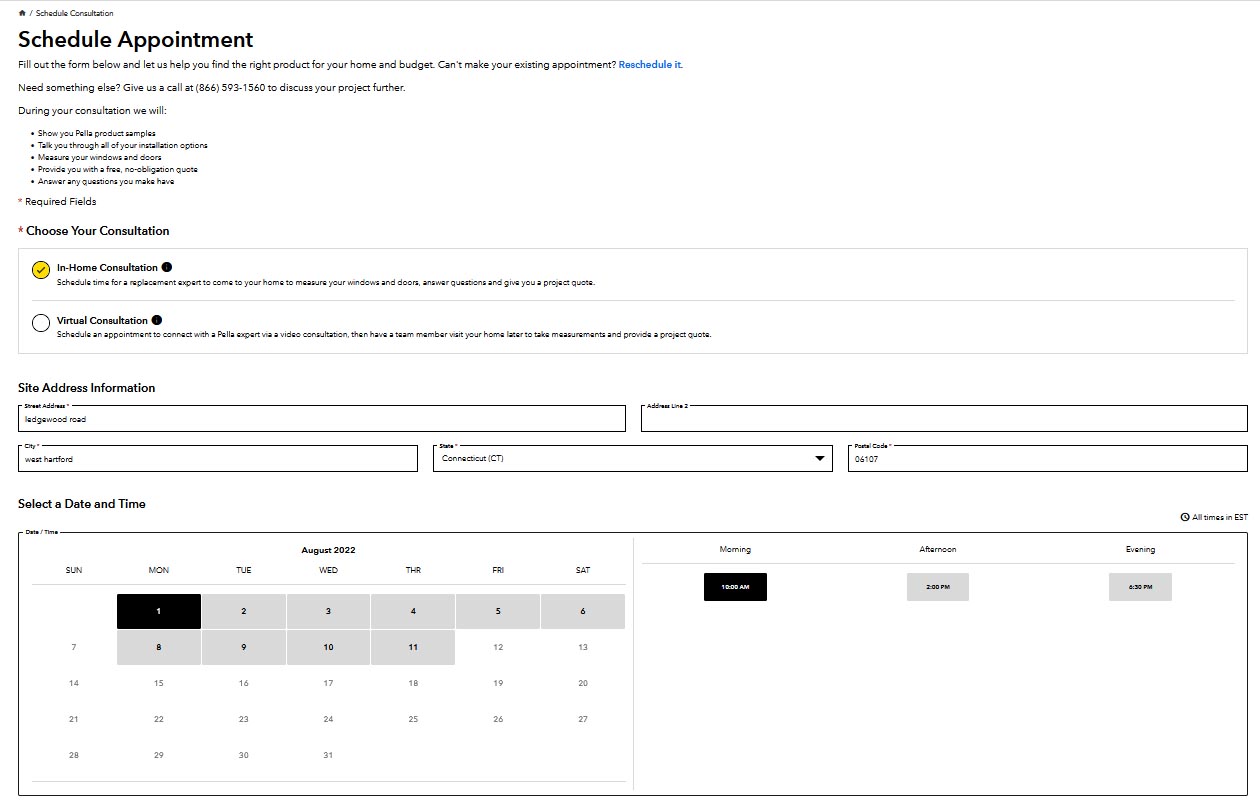
Installation Process
When choosing replacement windows, customers have two primary options: pocket installation (sometimes called inserts) or full-frame installation. Pocket inserts fit inside the frame of the existing windows, so if the existing frames are in good condition and the customer chooses to replace the window with the same type and size, pocket installations are less labor-intensive and thus less expensive to install. Pockets do, however, reduce the area of visibility slightly. Full-frame installations require the entire existing window and frame to be removed prior to installing the new unit, so this choice is ideal if the shape or size of the window is being changed or if there’s a need to reinsulate the walls surrounding the frame.
The installation process also varies somewhat based on where and how the customer has purchased the windows. Should the customer opt to handle the installation themselves, Pella provides detailed installation guides on its website and offers installation supplies (including a complete kit) in its showrooms, on its website, and at Lowe’s stores. Windows can also be delivered to a jobsite if a customer is already working with a contractor. To ensure that the windows are installed to Pella’s highest standards, customers can choose to work with a Pella Certified contractor. Pella offers training and support to contractors who express interest and grades the contractors based on their level of training and experience with Pella products. Contractors who have received training can display a “We offer Pella” logo, while contractors who have earned distinctions can denote their status as a Pella Certified Contractor, Platinum Certified Contractor, or Elite Platinum Certified Contractor. A consultant or showroom expert can guide customers through the process of selecting the installer, or customers can browse through certified contractors in their area on Pella’s website and request installation quotes directly.
Customer Service
The Support page on Pella’s website is robust and well organized. Large, visible buttons invite customers to click on frequently used services, such as scheduling service, warranties, or finding product serial numbers, without digging any further. Two drop-down menus offer a raft of more detailed options for homeowner and professional support topics, including a help library and owners’ manuals. A long list of help topics and frequently asked questions rounds out the choices for customers and pros to find their own answers. It’s gratifying for customers to see that just below all of this DIY assistance, Pella has listed multiple ways to contact a person directly, along with customer service hours of operation to reduce frustration for customers seeking assistance. Customers can call, text, or email a Pella representative with questions about windows, patio doors, and entry doors, while a separate team answers questions about storm doors via phone, chat, or email. Pella has also provided a mailing address. It’s impressive that Pella has opted to put so many pathways to assistance in clear view.
Cost and Financing
According to Pella’s website, the average replacement window costs between $200 and $900. Considering the variations of window sizes, materials, hardware, and accessories, this seems fairly reasonable—until the cost of installation is taken into account and a customer suddenly realizes just how many windows are in their home. It’s important to consider a consultation, either in-home or virtual, before making assumptions about the cost. Oddly shaped windows can cost much more, while standard windows in a budget line may cost much less than expected.
Although many customers choose to pay for their window projects using savings, credit, or a home equity line of credit or home improvement loan, Pella has partnered with Wells Fargo Bank to offer another option for customers in the United States. The Pella Windows & Doors credit card, which customers can apply for directly through Pella’s website, is a revolving line of credit that customers can use immediately and for future purchases. The card regularly provides promotions including no interest for introductory periods of time and options for equal or fixed monthly payments that work within a customer’s budget. This can be a great way for customers to stretch out the payments for a window project, especially when there’s a generous interest-free period available; however, when that period ends the interest rate for any remaining balance leaps significantly.
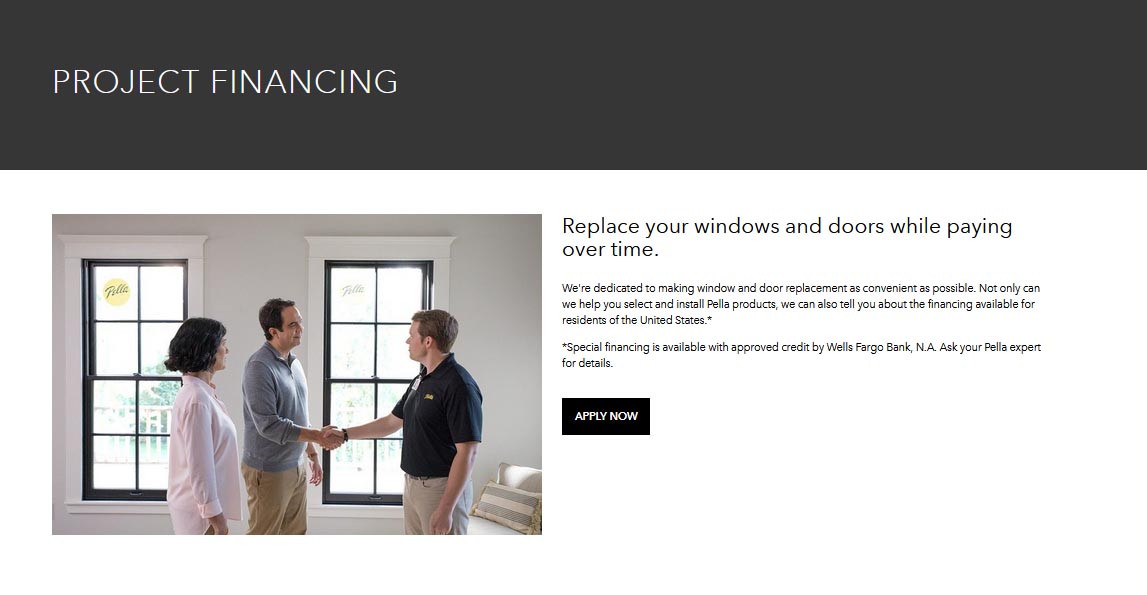
Warranty
Pella offers one of the best warranties on its products in the industry, with one hang-up. The nonglass components of the windows have a limited lifetime warranty, while the glass is guaranteed for 10 years (laminated glass) or 20 years (nonlaminated glass). In addition, the warranty covers labor for repair or replacement for warranty-covered problems for 2 years. This warranty demonstrates Pella’s confidence in its product; the company is sure that the majority of its doors and windows are going to last.
Unfortunately, the limited lifetime warranty on the nonglass components of the windows is not transferable. This means if a customer sells their home 5 years after the windows were purchased, the new owners are left without a warranty on the windows, as the warranty exists only as long as the purchaser owns the home. This can reduce the resale value of the home—a buyer looking at a house with new windows may know they’re paying a premium for those windows and may expect that they’ll be accompanied by a warranty. As a result, a customer may not recoup the money they put into purchasing the windows in their resale value.
Pella Windows Reviews by Customers
Reviews on Pella windows at Angi and ConsumerAffairs indicate that customers are generally pleased with the consultation experts; the feeling is that consultants were friendly and knowledgeable and walked them carefully through the process. Several reviews for Pella windows mentioned a long wait between ordering and installation, which customers found frustrating, though whether this is a problem with Pella’s manufacturing and shipping schedule or general supply chain delays is difficult to determine. A negative review of Pella windows (supported by several others) suggested that the windows swelled or failed to close properly after a few years; Pella’s response to those customers was reportedly that the installation had not been done properly to seal the windows, but that’s also difficult to verify. It’s also worth noting that quite a few negative reviews were regarding contractors and installation problems. As Pella doesn’t require customers to use Pella Certified Contractors, there’s no way to know if the contractors mentioned in these reviews were connected to the company or not. In general, reviews are largely positive, but they do suggest that choosing a Pella installer and planning projects well ahead of the desired completion date would be a good plan.
Pella’s website features ratings and reviews from its own customers, and while those reviews are largely positive, the company has been careful to include ratings that include some minor complaints or dissatisfaction as well. These reviews are separated based on the product (doors or windows) and the product lines they address, so they’re helpful for customers considering a particular line who want to see what previous buyers liked or did not.
How Pella Stacks Up to the Competition
One of Pella’s most direct competitors is Renewal by Andersen, and the quality of the products is quite similar (we also reviewed Renewal by Andersen). Pella’s windows are available in more materials and styles than Renewal by Andersen, and they are similar in cost when comparing the same materials. Renewal by Andersen does require, as part of its Signature Service, that its windows be installed only by the company’s own trained installers. This prevents customers from shopping around for their own contractor or installing the windows themselves, potentially removing an opportunity for cost savings, but Renewal by Andersen argues that the quality of the installation is just as important as the quality of the product. Pella allows outside contractors and DIY installers to install its windows, but it does heartily recommend choosing a Pella Certified Contractor to ensure quality.
Renewal by Andersen also offers a transferable warranty. For some customers, this may be a deciding factor. If it’s not a deal-breaker, however, Pella’s range of styles and materials is superior to Andersen’s, and the option to select the installer may be a significant enough factor to make Pella the right choice for those customers.
Should You Choose Pella?
Pella is an excellent option for homeowners who are interested in replacing windows with high-quality, high-efficiency windows that combine style with excellent construction. While Pella doesn’t provide the concierge start-to-finish service that some companies do, the different product lines, different materials, and enormous range of options make it worth the minor hassle of hiring an installer. It’s also a great choice for homeowners inclined to do the installation themselves; supplies for smaller jobs can quickly and easily be ordered online, or in some cases picked up at a showroom or Lowe’s store. While it’s not ideal that the warranty can’t be transferred, that shouldn’t be a deterrent for homeowners who plan to remain in their home for a longer period of time, and it may not be a problem for others. Those looking for a truly full-service experience may want to consider some of the other options, but for most everyone else, Pella is a solid choice.
We independently reviewed this service by weighing the company’s claims against first-hand experience with its professionals. However, due to factors such as franchising, human error, and more, please note that individual experiences with this company may vary.

